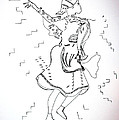Looking for design inspiration? Browse our curated collections!
Joined
2009
Followers
380
Visitors
1,483,012

Kalinka Dance - Russia
Russian folk dance was and continues to be an important part of their culture. Traditional Russian folk dance has its origins in various groups. These include: Slovenian and Tatar origins.[1]Costumes were beautifully designed with great detail. Typically, the clothing for the dances were based on specific events, such as holidays, and would vary between these events. Russian folk dance traditions continue to play an important influence in various sectors of Russian culture. These include in the areas of music and dance. One example can be seen in the Ballet Russ, which invoked Russian folk dances and music into its pieces. "Kalinka" (Russian: Úðûøýúð) is a Russian song written in 1860 by the composer and folklorist Ivan Larionov and first performed in Saratov as part of a theatrical entertainment that he had composed.[1] Soon it was added to the repertory of a folk choral group. The refrain of the song refers to the kalinka, which is the snowball tree. It has a speedy tempo and light-hearted lyrics. Kalinka Malinka is a traditional Russian folk song that has evolved into a dance, also called the Kalinka. Kalinka has continued to play an important role in Russian culture and folk music and is often played to modern rock or club beats. Kalinka is a name, and as such has no inherent meaning. Related Searches: • Ballet Dance Bar • Russian 1. Origins of the Song o Kalinka was written by Russian composer and theater performer Ivan Petrovich Larionov in 1860. It quickly became a popular folk song around which developed an energetic dance tradition. Kalinka is played at many gatherings, including weddings, parties or any celebratory occasion. Kalinka During the Soviet Union o Kalinka was frequently performed by the Red Army Choir of the Soviet Union because of its deep roots in Russian culture. There are many recordings and videos of these performances, which focus on the power of the song to express aspects of the Russian culture. On the surface of the song, it celebrates a snowball tree. However, the song has many phrases that have double messages in Russian and it can't be accurately translated into English. Use in Tetris o The video game Tetris was developed in Russia in the 1990s. When both Atari and Nintendo released versions of the game, they included electronic versions of Kalinka Malinka. Kalinka in Popular Culture o The quick rhythms and intense emotions in Kalinka have allowed it to be transformed into modern performances, especially in club music and electronica mixes. Many unique and unusual versions of the song have been recorded for use in popular modern dance clubs. A recent club mix of Kalinka was produced by Party Factory on Storm Records. Traditional Kalinka Dance o A tradition of dancing developed around the song Kalinka. Kalinka dances are notable for the crossed arms and kicks of the dancers. Dancing to the song often spontaneously broke out at private parties and eventually evolved into choreographed performances. Modern Kalinka o The popularity of Kalinka in Russian culture, music and dance allowed for its movement into more modern interpretations, like performances by Ielena Merzoian. Although there are modern aspects to many performances, traditional poses, positions and choreography are often retained.